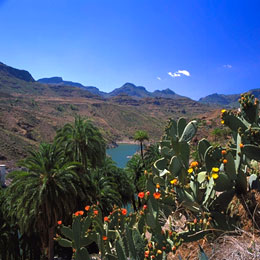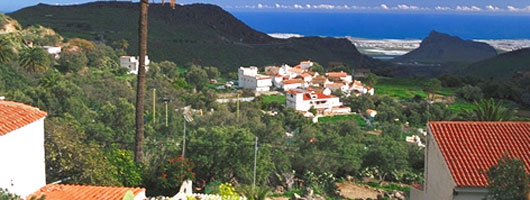On December 13th the fiestas in honour of the patron saint, Santa Lucía, are held. These fiestas have been declared a tourist attraction, as they manage to combine religious festivals with public sentiment.
Arising from this combination of originality and tradition are events such as the procession of the image of Santa Lucía on December 13th, the crowning of ‘La Lucía’ together with her Swedish namesake, and the Procession of the Day of the Labourer on the following Sunday.

The Day of the Labourer, the fiesta in honour of la Virgen del Rosario, is an event which attracts a large number of visitors. These days it is a procession where thousands of participants gather, dressed in typical costumes: black hat, espadrilles, the Canary Islands knife, the pumpkin full of mejunje (a local liquor), wine, rum or water, and with typical food such as goat cheese, pork crackling, small cakes, a block of gofio and fried sardines.
On this day, carts drawn by tractor or cattle go through the streets of the town offering such products for the many visitors to try.
Finally, on October 24th the fiesta in honour of San Rafael is held in Vecindario. This is a local fiesta of the municipality and includes among other events a large cattle show.
After the completion of the conquest of the island, Tomás Rodríguez de Palencia received the lands and water resources of the region for services to the Crown.
Like much of the land of the southeast of the island, these lands were at first used for sugar crops, a product which was almost entirely exported to markets such as America and the north of Europe. For this reason, a sugar mill with the name of "Ingenio Rojo de Tirajana" was built, which was to become the mainstay of the agricultural and industrial activity of the region.


Although sugar had a predominant role, cereals such as wheat, barley and rye held an important place in the economy of Santa Lucía from the sixteenth to the eighteenth century, as this was the food base of society under the Antiguo Régimen. All landowners used part of their land for cereal crops, and it can be seen that the major part of the Tirajana plantation was planted with sugar cane, although there were small plots for growing cereals which were most likely used for providing food for the large number of workers.
Fruit trees and palm trees for handcrafts (using the leaves) were other important crops in Santa Lucía.
The sixteenth century brought important economic activity based on grape crops, and from this time olive trees existing in the present day were probably also introduced. Recent studies have established these olive trees as an autochthonous species and therefore unique in the world. Their fruit is very well known in the Canary Islands as "Santa Lucía olives".
In 1815 the municipality of Santa Lucía was constituted, the year following the building of the parish church which gave its name to the municipality.
Santa Lucía - capital of the municipality – is 680 metres above sea level, and 51 kilometres from the capital of the island, Las Palmas de Gran Canaria. The municipality has a surface area of 61.55 square kilometres, in the shape of a geographical wedge, from the central peaks of the island in la Sepultura del Gigante to the southeast coast of Gran Canaria (Pozo Izquierdo and Bahía de Formas).

Historically, the municipality has always been divided into two distinct areas: the interior, where the capital Santa Lucía is located, and the coast, with the three main settlements of the municipality (Vecindario, Sardina del Sur and El Doctoral).
The interior is predominantly an agricultural area which forms a large oasis in the centre of the rocky slopes of la Caldera de Tirajana, made up of several rural settlements (El Ingenio, Rosiana, La Sorrueda, etc.) with beautiful palm groves and areas of crops.
The interior has been populated since ancient times. A large number of pre-Hispanic remains have been found in the area, demonstrating that it was witness to the final episodes of the conquest of Gran Canaria.
Towards the coast the protruding rock formation, Ansite, is the fortress from where the natives of the island withstood the final siege of the Castilian troops. In this landscape of cliffs, rock formations and plunging ravines, visitors can feel in touch with the early inhabitants of Gran Canaria, both in terms of the spectacular nature of the area and because it is the part of the island which has been least touched by humans.
Until the nineteenth century the people of Santa Lucía were involved exclusively in agricultural work, primarily as ‘medianeros’ (having half a share with the landowner). However, at the beginning of the twentieth century there were major modifications in the economy of the area. Entrepreneurs saw the good climate, cheap land and large plains in the southeast of the island: just the place for intensive tomato cropping. Owners of large tracts of land invested by ploughing new land and improving it for production. Stores were built and, in particular, wells were sunk for water.

Intensive production began on previously sterile land near the coast, creating thousands of jobs: sharecroppers and itinerant labourers who subsisted on minimum wages and in uncomfortable living conditions.
Since 1960 Santa Lucía has also been involved in the growth of tourism in the south of the island and has become the place of residence of many of the workers in the building and hospitality industries.
Today Santa Lucía is the major exporter of tomatoes in the Canary Islands, which gives an idea of the importance of this crop in the social cohesion of the area.
In the same way, the coastal area of the municipality has been consolidated as an area of major economic growth due to the commercial activity in the area: El Doctoral, Sardina del Sur and, above all, Vecindario, have become important economic and commercial centres in the southeast of the Island.